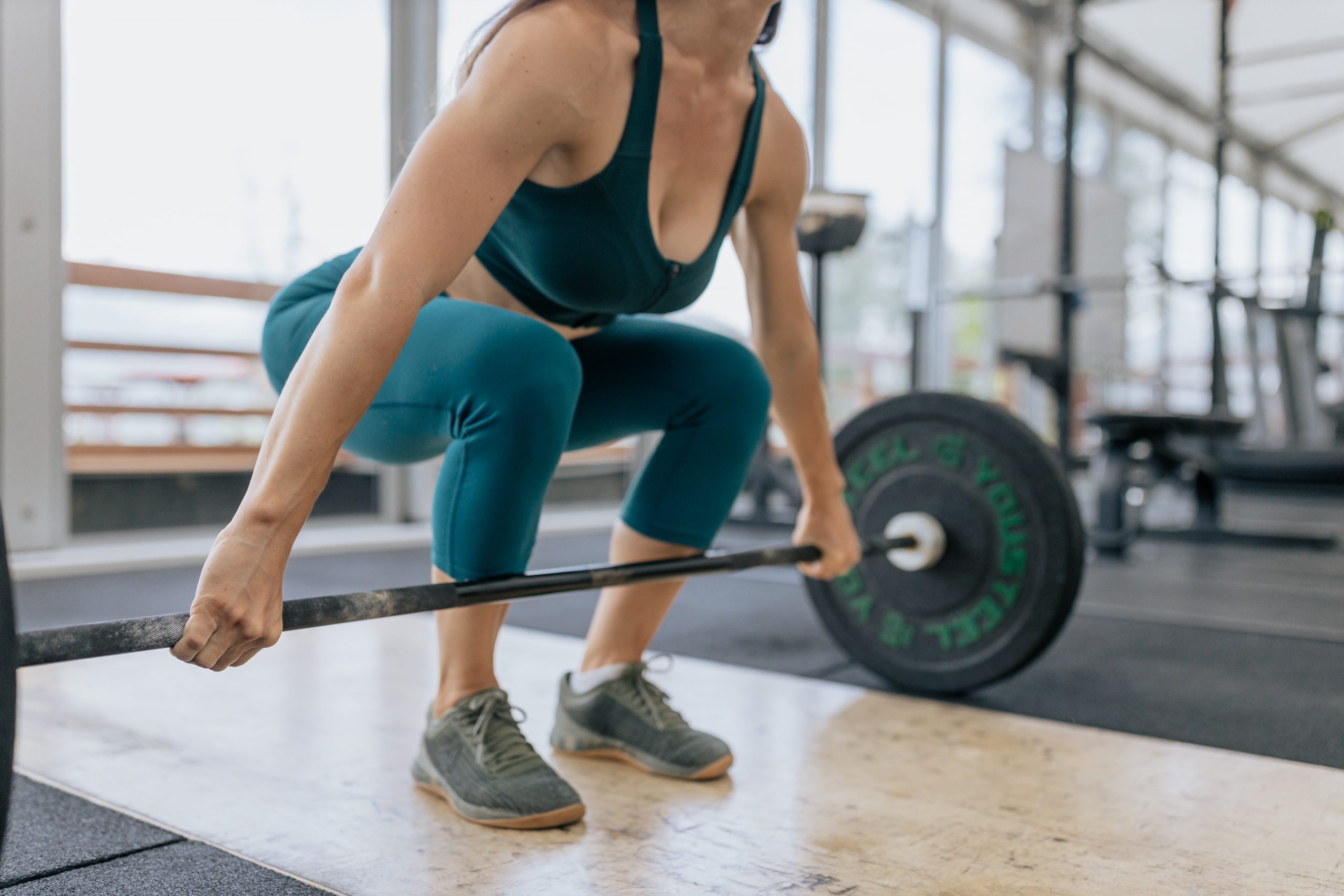As someone deeply passionate about women’s health and fitness, I’m often asked, “What are the best workouts for women over 40?”
It’s a question that hits close to home because, let’s be honest, our bodies don’t respond to exercise like they used to in our younger days.
And what’s frustrating is that many supposed “experts” out there fail to grasp why this happens.
Instead, they perpetuate the myth that weight gain and decreased fitness are just inevitable signs of aging.
Hormonal changes beyond your 40s
The truth: when we hit our forties, changes start kicking in, especially as we navigate peri-menopause.
It’s during this time that our hormone levels, like estrogen and progesterone, start to fluctuate and decline.
And here’s the kicker:
recent research has shown that it’s not necessarily our age that’s to blame, but rather the drop in estrogen levels that’s mainly responsible for issues like:
- bone density loss
- weight gain, and
- lean-muscle loss
during menopause.
Muscle changes as we age
We ladies naturally start out with less muscle than the guys, and guess what?
We lose it even faster as we age.
It’s kind of like our bodies aren’t super enthusiastic about holding onto muscle after a certain point, thanks to our hormones (especially estrogen) taking a backseat.
- Between ages 30-80, most women lose around 3% of their muscle mass every ten years. (The fancy term for ‘muscle loss’ as we age is ‘sarcopenia‘, and it happens to men too).
- Strength takes an even bigger hit with a whopping 30% drop between ages 50-70, and gets much worse after that!
- Without intervention, you can lose up to 50 percent of your lean skeletal muscle mass by your 80th birthday” (for the full scoop, see Why Women Need More Strength and Less Cardio Training).
See How My 10 Week Workout Plan For Women 40+ Will Help You Reach Your Goals

- Lose post 40-60s fat
- Get fit and strong
- Balance your hormones
- Manage stress and limiting beliefs
Remember, the more muscle you have, the higher your resting metabolic rate (RMR).
This basically means your body burns more calories even when you’re chilling on the couch.
So, the bottom line is this: women start with less muscle, lose it faster, and then have hormonal shifts that make it even harder to keep it.
Not exactly the recipe for building a strong, metabolically-active body, right?
The good news?
We’re not powerless!
Choosing the best workouts for women over 40 can help counteract the unwanted effects of muscle, strength, and hormonal decline.
BEWARE OF THIS
Instead of making hormonally appropriate adjustments, women over 40 are commonly put on fat-free diets or advised to “eat less and exercise more“.
Here’s the truth: “Eat less, exercise more” might work for some, but it overlooks the significant role hormones play in our bodies, especially after 40.
Let’s face it, finding the best exercises for women over 40 goes beyond just burning calories.
Here’s the four best workouts women over 40 need to do to lose excess weight, stay strong and keep valuable muscle mass:
1. Strength Training (aka ‘Lift Heavy Shit’)
Forget light weights and endless reps.

You need to give your body a strong neuromuscular stimulus.
That comes in the form of heavy resistance/strength training – or Lifting Heavy Shit.
Now, before you get intimidated, “heavy” is a relative term.
It doesn’t mean you need to be hoisting barbells like a superhero.
What truly matters is how it feels for you.
LOSE WEIGHT & GET FIT for FREE with my Free 21 Day Plan For Women 40+
The key is to choose a weight that makes you work hard to complete each set.
I see way too many women in the gym using light weights and chatting away while doing reps.
That won’t get you the results you want.

The last 2-3 reps of each set should especially be challenging to complete.
I am talking a slowed down movement, possible shaking of the limb holding the weight, and absolutely pulling ugly faces.

Bear in mind though that the correct posture and technique need to be maintained throughout that grind.
This balance can take a bit of time and experimentation to find if you’re a beginner – a trainer can help here.
How many reps and sets?
For toning/muscle building, any of the following:
- 4-6 sets of 12 reps per exercise
- 5-7 sets of 10 reps per exercise
- 6-8 sets of 8 reps per exercise
If you can do more than 12 reps, the weights are not heavy enough.
For strength:
- 5 sets of 5 reps per exercise
- 6 sets of 4 reps per exercise
- 8 sets of 3 reps per exercise
- 10 sets of 2 reps per exercise
Weights must feel super heavy for you – you are in fact trying to get stronger. You should not be able to do more reps at the end of a set.
Rest periods and session length
For toning/muscle building:
- rest up to 60 seconds between sets – you should not be 100% recovered from the previous set when starting the next set
- session length should not last longer than 60min – longer than that will make it catabolic and too stressful on the body
For strength:
- rest 2 – 10 minutes between sets (the longer the better) – you should feel recovered from the previous set when starting the next set
- sessions can also last up to an hour, including rest periods
How often?
- strength: two days/week (the minimum for making progress), ideally three days/week
- toning/muscle building: 4-5 days/week
- See FAQ below to make sure you periodize workout and recovery weeks optimally!
Remember that every three weeks, you need to either change the exercises or the rep / set ranges to prevent hitting a plateau.
Benefits of Strength Training For Women Over 40:
(as recently posted by Dr. Stacy Sims):
- Reduced risk of chronic diseases:
- Research shows that resistance training is just as, if not more effective than aerobic exercise at reducing the risk for
- type 2 diabetes
- cardiovascular disease
- cancer
- and general disability.
- Research shows that resistance training is just as, if not more effective than aerobic exercise at reducing the risk for
- Improves fat burning metabolism
- this study shows that lower lean body mass (muscle) is by far the most important reason for the lower fat burning capacity in menopausal women
- Reduced risk of heart disease:
- A fascinating study found that people who did any amount of strength training on a weekly basis had a 40-70% reduced risk of developing
- heart attack
- stroke
- death related to heart disease
- compared with individuals who did no strength training.
- A fascinating study found that people who did any amount of strength training on a weekly basis had a 40-70% reduced risk of developing
- Improves bone mineral density in pre and post menopausal women:
- Research on premenopausal women shows that just six months of heavy resistance training improves bone mineral density of the hip joint and the lower back.
- In post menopausal women with low bone mineral density and osteoporosis of the spine and hip, strength training also can help maintain and increase bone mineral density.
- It’s an anti depressant:
- In a meta-analysis, resistance training significantly reduced depression symptoms in both women and men.
- In a Harvard study of 60 – 84 year olds with depression, 10 weeks of resistance training worked as an effective antidepressant. The harder they trained, the better the effects.
- Vitality and longevity:
- Strength training improves and maintains your grip strength.
- A 2022 study found that when comparing weight loss to grip strength, grip strength was a better indicator of longevity.
- Several other studies confirm this finding.
- Improved performance in any sport:
- A study from 2019 showed HEAVY (not the high rep, low weight nonsense so many distance runners love calling ‘strength training’) resistance training enhanced running economy in regular runners.
- They managed to cut 1 – 2min off 10k times!
2. High Intensity Interval Training (HIIT)
HIIT has become a fitness buzzword for a reason: it can be amazing for weight management, overall fitness, and building stamina – if you do it right.

The beauty of HIIT?
You can use almost any exercise!
The best choices are usually compound movements, which work multiple muscle groups at once.
Think squats (and all their variations!), pushing and pulling exercises for your upper body, swings, burpees, lunges, thrusters – the kind of stuff you might see in a CrossFit gym.
Don’t forget bodyweight exercises like jumping lunges, skipping, mountain climbers, pistol squats (single-leg squats), jumping jacks, pull-ups, push ups, or squat jumps.
You can even turn your cardio exercises such as running, speed walking, hiking, cycling, rowing or swimming into potent HIIT sessions.
How many reps and sets?
- up to 20-30 reps per exercise, or 20-60s duration
Choose between:
- two to five exercises, with 10-20 reps of each, and repeat for as many rounds as possible (AMRAP) in say, 15 minutes (rest only when needed)
- the same amount of exercises, but do a certain amount of rounds (like three or more) for time (see how quickly you can get it done)
- one or two movements and do them every minute on the minute (EMOM) for say, 10 or 15 minutes
- a TABATA workout – 20s all out, 10s rest x 8, which totals four minutes. Tabata can (and maybe should) be BRUTAL if done correctly. Choose any exercise. Do about three rounds with 3-5min rest between each set
There are more possibilities, as you can imagine. One can get creative.
Rest periods and session length
- very short or even no rest periods (in which case the workout should be about 15min max – this applies to the first three examples above – AMRAP, EMOM and ‘for time‘)
- if you do Tabata, three or four rounds max (depending on the exercises used) with a 3-5min rest between each will total around 30min for the workouts.
How often?
- no more than twice or three times a week as these sort of workouts are stressful on the body
- you’ll need 48h rest in between HIIT sessions
- (My 21 Day Plan For Women 40+ consists of 3 HIIT sessions/week, however they are carefully designed with adequate rest and therefore allows for 3 sessions per week)
More or longer sessions when it comes to HIIT is NOT better and NOT recommended.
Benefits of HIIT For Women Over 40:
- sessions can be done in under 30min
- helps manage stress (if not done too often or for too long)
- lowers anxiety (in women who did three sessions per week)
- improves glycolytic capacity in the brain to sustain a better cognition and slow down or prevent the progression of Alzheimer’s disease
- increased information processing speed
- A study published in Cell Metabolism found that HIIT:
- contributes to protein synthesis, thus reversing a major adverse effect of aging
- improves aerobic capacity and mitochondrial function for skeletal muscle
- improves
- cardio respiratory health
- muscle mass
- insulin sensitivity
3. Sprint Interval Training (SIT)
Sprints aren’t just for young athletes! They’re a fantastic workout for women over 40, offering a great return on investment (ROI) for your time.

Our fast-twitch muscle fibers are the first to deteriorate with age and inactivity.
SIT fires up these muscle fibers to keep them strong and alive as we get older.
The ability to react and exert force swiftly is crucial for preventing falls than strength alone.
But I think a hot favourite benefit of doing sprints will be its favourable effect on burning belly fat:
“Remember, levels of your stress hormone, cortisol, rise during menopause. That sets you up for a vicious cycle of storing belly fat, which produces more inflammation and stress. In fact, deep belly fat has about four times as many cortisol receptors as the regular fat that sits under your skjn. So not only does deep belly fat trigger more cortisol production, it also leads to more belly fat storage. SIT breaks this cycle.
Dr. Stacy Sims
How many reps and sets?
- 6 sprints of 10-30s each
You don’t have to do running sprints – you can do sprints on stationary cardio equipment like a spin bike, rower or elliptical etc. too.
Rest periods and session length
- 2min rest between each sprint
- sessions can take about 25min max
How often?
- once or twice a week (HIIT and SIT together can total twice per week)
Benefits of SIT For Women Over 40:
- sessions can be done in under 25min
- improves insulin sensitivity
- increase lean muscle mass and reduce fat in a relatively short period of time – study
- improved fat burning (especially deep visceral/belly fat)
- lowers fasting blood sugar levels
- trains your body to burn more fat for energy when you’re not exercising
- stronger mitochondria
- boost of growth hormone after you finish
- Research shows SIT also helps increase lean muscle mass, as well as improve power and cardiovascular fitness.
4. Plyometric Training (Plyometrics)
Plyometrics basically is ‘jump training’ and should be introduced last, after LHS, HIIT and SIT.

Women naturally have less of a specific type of muscle fiber called Type IIb.
These are the powerhouses that help us generate force and explosiveness.
Unfortunately, as we approach and enter menopause, we lose these fibers even faster.
Plyometric exercises are needed for maintaining and keeping these muscle fibres strong.
Start with easy movements like jumping jacks, skipping, skater hops, and low box jumps before progressing to more advanced exercises.
Plyometrics should only be done if you:
- have done regular strength training for at least two months
- have no injuries
- are well rested
- are well warmed up
How many reps and sets?
- once a week
- add a second session or more advanced exercises after two months
Rest periods and session length
- session length: up to 20 minutes is enough – it’s not supposed to tire you
- rest periods: 2 – 5 min, or the same as when training for strength
How often?
- once a week
- add a second session or more advanced exercises after two months
Plyometric training is about full effort, powerful, quality movements – NOT getting tired. This is why these workouts should be done with fresh legs.
Benefits of Plyometric Training For Women Over 40:
- sessions are short and can be done as part of a warm-up routine
- good for building bones which is much needed as estrogen and bone density declines
- makes your muscles more efficient at storing carbohydrates
- improve insulin sensitivity
- it will make you a more efficient road and especially trail runner
Don’t be scared of BULK. Be scared of muscle LOSS
Sadly, society and the fitness industry has feminized aerobic classes and the cardio section, and masculinized the weight section of the gym.
That is NOT in the best interests of women – not for health, not for longevity, and not for body composition.
But I think this is changing, which is great – albeit slow.
FAQ

I really LOVE cardio / endurance sport, what now?!
You can keep crushing distances, but for optimal results as you age, consider adding 2 x strength sessions to your weekly routine. This might mean shorter runs/rides (2h ride instead of 3h) to ensure you can recover effectively.
Are these exercises the same for women in peri menopause, menopause and post menopause?
That is correct.
The training changes you implement during the transition from peri menopause all the way to post menopause (about 40 – 60+) remain the same.
Just be mindful that recovery time takes longer as you enter menopause.
What if I had a hysterectomy?
If you did not have your ovaries removed, you will go into peri-menopause and menopause the same as any other woman. If you had one removed, it will still be the same, as far as I understand.
I am premenopausal and still get my period every 28 days – how should I structure workouts and recovery?
If you had both ovaries removed, however, your hormones will be the same as a woman in menopause.
If your cycle is 28 days, you can train the hardest for the first 2-3 weeks of your cycle.
The week before your period starts again, is when you want to recover and take things easy.
If you have a race in the week before your period, you will need to take in more carbs/glucose during the race.
Won’t I bulk up if I start lifting weights?
Not very easily at all.
It becomes especially hard from per-menopause onwards.
I am 40 but not yet in peri menopause – when should I start training like this?
NOW.
Research found that peri menopausal women can avoid the loss of muscle and unfavourable metabolic changes by doing resistance and HIIT training.
However – it is NEVER too late to start!
I don’t like the gym
You don’t have to. There is a lot of strength training that can be done without going to the gym – HIIT and plyometrics too.
You can easily get by with two sets of weights at home.
Conclusion
- Start off with strength training (Lifting Heavy Shit) twice a week, build to three times per week.
- Make sure you always use the correct posture and technique – a mirror can help if you don’t have a trainer.
- Add one HIIT session per week after a minimum of two months of strength training.
- Bring in a SIT session once per week after at least another month.
- After doing the above (a total of at least 4 months), bring in one easy plyometrics session per week. Slowly increase the difficulty of the exercises.
- Every three weeks, change the exercises or the rep / set ranges to prevent hitting a plateau.
- For maintenance: keep doing 2-3 strength training sessions/week and alternate HIIT, SIT and Plyometrics to total 2 sessions/week.
- Make sure you recover properly between sessions by eating and sleeping appropriately, and managing stress.
- Do not do workouts when you are sleep deprived, chronically stressed, or not recovered from a previous session.
If you’ve already added Strength Training, HIIT, Sprint Training or Plyometrics to your workout regime, what changes have you noticed to your body or fitness?
Check out my FREE 21 Day Plan For Women 40+, my 10 Week Plan For Women 40+, or let me work a plan out for you.


I have read some excellent stuff here Definitely value bookmarking for revisiting I wonder how much effort you put to make the sort of excellent informative website.
Your writing has a way of making even the most complex topics accessible and engaging. I’m constantly impressed by your ability to distill complicated concepts into easy-to-understand language.